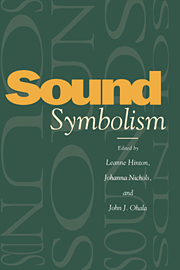Book contents
- Frontmatter
- Contents
- List of contributors
- 1 Introduction: Sound-symbolic processes
- PART I Native American languages north of Mexico
- PART II Native languages of Latin America
- PART III Asia
- PART IV Australia and Africa
- PART V Europe
- 14 Regular sound development, phonosymbolic orchestration, disambiguation of homonyms
- 15 Modern Greek ts: beyond sound symbolism
- 16 On levels of analysis of sound symbolism in poetry, with an application to Russian poetry
- 17 Finnish and Gilyak sound symbolism – the interplay between system and history
- PART VI English
- PART VII The biological bases of sound symbolism
- Index
15 - Modern Greek ts: beyond sound symbolism
Published online by Cambridge University Press: 04 August 2010
- Frontmatter
- Contents
- List of contributors
- 1 Introduction: Sound-symbolic processes
- PART I Native American languages north of Mexico
- PART II Native languages of Latin America
- PART III Asia
- PART IV Australia and Africa
- PART V Europe
- 14 Regular sound development, phonosymbolic orchestration, disambiguation of homonyms
- 15 Modern Greek ts: beyond sound symbolism
- 16 On levels of analysis of sound symbolism in poetry, with an application to Russian poetry
- 17 Finnish and Gilyak sound symbolism – the interplay between system and history
- PART VI English
- PART VII The biological bases of sound symbolism
- Index
Summary
Introductory remarks
The phenomenon of sound symbolism in language in general and in individual languages is undeniably noteworthy and of interest in its own right. However, it is often the case that sound symbolism is but one facet of a more comprehensive and extensive set of expressive linguistic domains. It therefore turns out that in order to fully understand this phenomenon, one must view it within such a broader context.
In this paper, a detailed case study from Modern Greek is presented in order to document the complexity of the interaction between a language's sound-symbolic elements and its other exponents of expressivity. This complexity is apparent not only in the synchronic intertwining of various expressive elements but also in the nature of the diachronic developments that give rise to the synchronic state. The lesson to be learned from this is that the identification of a given element as a sound symbol generally yields just the tip of the phonosemantic iceberg, a point of departure for an investigation of the workings and origins of the more iconic and expressive realms in a language.
It is useful at this point to introduce some terminology for referring collectively to the various aspects of a language which contribute to a language's expressivity through the iconicity, the colour, the connotative value, and the like that they display. Following Wescott (1975: 497), the expressive domains in a language can be lumped together as “allolanguage,” and characterized as those aspects “that [are] alienated from conventionally structured speech,” so-called “microlanguage.”
- Type
- Chapter
- Information
- Sound Symbolism , pp. 222 - 236Publisher: Cambridge University PressPrint publication year: 1995
- 1
- Cited by



